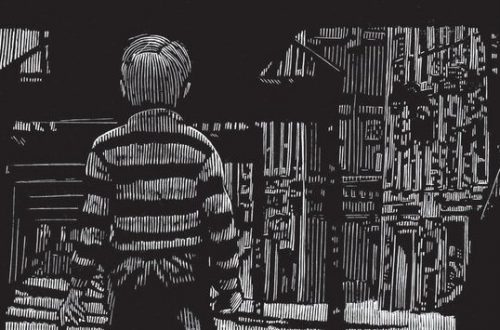“The Road goes ever on and on…”
Towards the end of J.R.R. Tolkien’s The Hobbit, Bilbo returns from his long adventure, which did indeed make him late for dinner, and sees the Shire for the first time in months. When setting eyes upon his homeland he exclaims:
Roads go ever ever on,
Over rock and under tree,
By caves where never sun has shone,
By streams that never find the sea;
Over snow by winter sown,
And through the merry flowers of June,
Over grass and over stone,
And under mountains of the moon.
Roads go ever ever on
Under cloud and under star,
Yet feet that wandering have gone
Turn at last to home afar.
Eyes that fire and sword have seen
And horror in the halls of stone
Look at last on meadows green
And trees and hills they long have known.
Certainly Tolkien’s literary roads have ranged far and wide throughout Middle Earth with his many tales of that robust, complex, and wonderfully enchanting world. And yet, another verse of this poem from Bilbo, this time spoken at the beginning of the Lord of the Rings when Bilbo is leaving the Shire to make his way to Rivendell, may help introduce the other tales of Tolkien, those beyond Middle Earth.
The Road goes ever on and on,
Down from the door where it began.
Now far ahead the Road has gone,
And I must follow, if I can,
Pursuing it with eager feet,
Until it joins some larger way
Where many paths and errands meet.
And whither then? I cannot say.
“The Road” – the road of literature more broadly. For Tolkien, this road sometimes led to Middle Earth and sometimes ran alongside it.
At other times it went in an utterly different direction.
One such story Tolkien worked on was the poem Aotrou and Itruon (Breton terms for Lord and Lady). Originally published in The Welsh Review in 1945, it has recently been collected with other related pieces and republished in 2016 – I happened across it in Barnes and Noble. This is a lay firmly in the Celtic tradition, telling of a Lord and Lady wishing for children. While the title focuses on the Lord and Lady, the main character is, in reality, the much darker witch (a Celtic fairy woman or corrigan). Tolkien’s description of her is both eerie and gripping. In the woods where the Lord travels one day:
A witch there was, who webs could weave
to snare the heart and wits to reave (steal),
who span dark spells with spider-craft,
and as she span she softly laughed;
a drink she brewed of strength and dread
to bind the quick and stir the dead.
She knows, even as he approaches her, the desire of the Lord to have children with his beloved Lady.
One of Tolkien’s darker tales, Aotrou and Itruon has the witch wreak havoc on the unfortunate and beset Lord and Lady. The Lord agrees to take a phial of potion without payment, only that the witch will exact recompense at some later time. The Lord brings the potion back to his Lady, administering it to her unawares. They do conceive and have fraternal twins. Just upon their birth, the Lord rides in the woods again, coming across the witch once more. She now tells what is due to her for the potion: the Lord as her husband. He, naturally, refuses and is cursed by the witch that he will die within three days. The ending is harsh and tragic, a tale of drives, desires, the deceptions of others, the waywardness of our own plans.
Of a strikingly different tone is the story Farmer Giles of Ham. In this tale, Tolkien tells the unwanted fortunes of Aegidius Ahenobarbus Julius Agricola de Hammo. This was his full name in proper Latin form, but by the time of the story no one worried about such formal appellations any more, so he was simply Farmer Giles of Ham. From the very beginning, we see Tolkien spoofing the regal and legendary, giving both very modest and down-to-earth tellings. On the first page we are told:
Farmer Giles had a dog. The dog’s name was Garm. Dogs had to be content with short names in the vernacular: the Book-latin was reserved for their betters. Garm could not talk even dog-latin; but he could use the vulgar tongue (as could most dogs of his day) either to bully or brag or to wheedle in.
It is Garm who warns Farmer Giles one day that a giant (unheard of near Ham for generations) has caused damage to the countryside and may be a danger to the village.
Farmer Giles, after some old-married-couple-bickering with his wife about his crazy dog and its news, takes up his Blunderbuss (no one else in the village has one) and goes out nonetheless to encounter the giant. This light-hearted and comical tale pokes fun at a world of inherited medieval monarchical status and social expectations therein. It is, quite simply, a joy to read.
If you have enjoyed The Hobbit, The Lord of the Rings, or maybe even the Silmarillion, it might be time to explore some of these or other of Tolkien’s lesser-known stories. They are very much worth worthy of reading. If for no other reason than that they admit us as readers into other worlds – worlds which make sense on their own; worlds which help us to make better sense of our own; worlds which can entertain, inspire, and prompt contemplation of what is true, good, and beautiful.
The Published Stories of J.R.R. Tolkien
(This list excludes juvenalia, translations and adaptations, and the multi-volume Complete History of Middle Earth, which contains transcriptions of Tolkien’s original manuscripts, collected and presented by his son Christopher.)
- The Hobbit: or There and Back Again
- The Lord of the Rings
- The Silmarillion
- Tales from the Perilous Realm contains:
- “Farmer Giles of Ham”
- “The Adventures of Tom Bombadil”
- “Leaf by Niggle”
- “Smith of Wootton Major”
- The Children of Húrin
- The Legend of Sigurd and Gudrún
- The Lay of Aotrou and Itroun
- Beren and Lúthien
- The Fall of Gondolin





